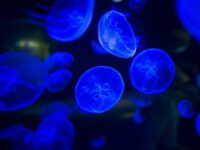Most people would turn to unnatural explanations when water and animals illuminate the night. In reality, organisms can chemically produce this light on their own. This phenomenon, called bioluminescence, occurs in organisms such as bacteria, algae, plankton, crustaceans, and even fish. But what generates the ethereal glow and why?
Bioluminescence occurs when a light-emitting molecule called a luciferin becomes oxidized in the presence of a catalyzing enzyme.
Photoproteins, a type of light-producing enzyme, are provoked to create light when binding to substances such as Ca2+ or Mg2+. Another form of luminescence is bacterial, which also requires a luciferase and oxidation. The light produced through bioluminescence is typically limited to blue-green wavelengths; a protein called aequorin gives off a photon of blue light, which is then “absorbed by [a] green fluorescent protein that emits a green photon, so [organisms] appear green,” comments Professor Joseph Ayers from the Department of Marine and Environmental Science at Northeastern University. However, animals can adjust the intensity and color of this light through control mechanisms like neurotransmitters.
For animals, their glow can act in their defense, conceal their shadow, stun prey, or act as a form of communication. But bioluminescence can be used by humans too, from detecting harmful algal bloom to modeling the ocean. In the field of biotechnology, bioluminescent imaging can perform noninvasive viewing of molecular activity. Beyond contemporary uses, perhaps speculative solutions to modern issues lie in our oceans.
Picture a future that exists inside the waters that humans have barely explored.
If sea waters rise and humans must build communities in conjunction with the ocean, new technologies and designs will be needed. Methods of communication might need to adapt to underwater environments. The sun might have to be replaced with manufactured light such as bioluminescence, as so many marine organisms have done before us.
If the evolution of light production occurs fairly easily, can humans or other animals adapt to bioluminescent behavior? With the rare and inspiring glow of bioluminescence, possibilities are endless.
Sources:
Annual Review of Marine Science (2010). DOI: 10.1146/annurev-marine-120308-081028 Journal of Photochemistry and Photobiology B: Biology (2017). DOI: 10.1016/j.jphotobiol.2017.05.021




